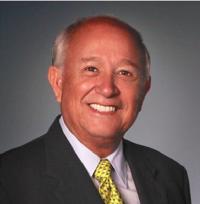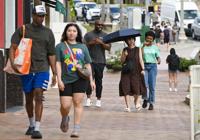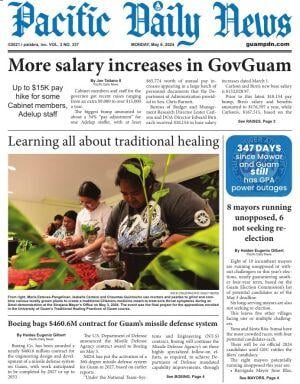Håfa Adai! If it makes sense, go with it. Don’t doubt yourself and second-guess the obvious in favor of some novel new approach lacking sufficient footing.
Go for sure-fire solutions. That’s what Destination Guam did when the going got rough and some vocal folks started suggesting that our island should shift away from tourism.
When travel went dark during COVID, certain outspoken commentators said Guam should invest more heavily into manufacturing, become an offshore banking hub, quit America and embrace self-sustaining independent sovereignty, go agrarian, become a U.S. retirement colony, or concentrate on the military leg of our economy more exclusively.
Although I bristle at the thought of Guam ever dropping its U.S. status, I applaud plausible diversification into any viable line of sustainable commerce that our island can grow and support.
But here at the Guam Visitors Bureau, we knew that none of the enterprises being kicked around during our destination’s COVID winter could exist in a vacuum. Nor that any of these “free rider” concepts would be less dependent on the critical mass created by the tourism dynamic within the foreseeable future.
Our island’s thriving transportation sector typically generates such enormous investment and expenditure that it drives liquidity into branches of the economy that become largely dependent on and symbiotic with transit-related activities such as tourism, cargo-shipping, logistics, and military deployment.
Remembering our roots
Just as it took decades to build the local visitor industry into the regional economic juggernaut it became long before the novel coronavirus arrived in 2020, it would take many years of trial, error, and steady progress to turn any other viable stock-in-trade into an economic powerhouse here on island.
In 1962, after President Kennedy lifted the Naval security clearance requirement barring free and unfettered civilian entry into Guam, tourism itself became a fledgling venture dependent on the good graces of a federal government that remains an even bigger juggernaut than our island’s visitor industry ever became.
Today, GVB counts Guam’s blessings in its role as host to a rebounding visitor industry and a robust and expanding military community. And we express our gratitude under the crystal clear realization that our island is known as much for tourism as it is for patriotic defense-readiness across the Pacific.
Patience and leverage
In the interval between tourism’s latest major setbacks on the one hand and total arrivals saturation on the other, Gov. Leon Guerrero, Lt. Gov. Tenorio, the Guam Legislature, government of Guam departments and agencies, and visitor industry players have clearly understood that Guam is better off going with what has always worked in the past: warmly welcoming the military and pouring recuperative resources back into tour and travel whenever they need a boost.
Even after devastating reversals like typhoons, earthquakes, airline disasters, warfare, global economic crises, and novel influenzas, tourism has consistently recovered lost ground.
And Guam’s visitor industry, in particular, has a demonstrable history of repeatedly bouncing back from such situations with renewed vigor and sustenance.
You see, the systems, habits, relationships, infrastructures, culture, and “muscle memory” know-how were already squarely in place for Destination Guam to keep edging ever closer to 2 million visitors per annum when the pandemic suddenly reached our shores and dramatically closed our island off as an accessible, leisurely getaway for the region.
COVID hurt Guam and so did Typhoon Mawar, but such traumatic shakeups and jarring breaks in cash flow are only temporary. The market is always there, even when it falls into a state of suspended animation. And when fresh infusions of private money sources freeze up, the government steps in to keep cash and credit circulating.
There is a deep and abiding conviction that tourism and the military keep Destination Guam’s economy healthy and vibrant, and that our island makes its best contributions to the region when its needs are being met.
Just as Guam sends linemen and care packages to storm-ravaged islands after a tropical cyclone knocks power out and spoils food supplies, the U.S. government declares emergencies and sends aid in Guam’s hour of need, too.
Each entity fully appreciates its role as a member of a consortium of allies who intrinsically value their own and one another’s freedom and interdependence.
Lifeblood
The visitor industry has been rebuilding momentum with the booster injection of federal and local monetary assistance since COVID and Mawar. Government aid has covered everything from bone-dry payrolls to the repair and replacement of storm-damaged equipment and real property assets to give businesses negatively impacted by these successive disasters a fighting chance to start producing taxable revenues again.
We know from eras past that this is how the U.S. government responds to its citizens in need, especially when catastrophe strikes. And so we go with what works.
As GVB cooperates with its partners to rebuild lost inbound passenger traffic through new and renewed air routes, creative air service agreements, and an increasingly robust cruise ship industry, Destination Guam’s recovering economy is also benefited by the timely bonus of mounting militarization across the Marianas and Micronesia.
Here again, we’re going with what has always worked in the past. The U.S. military has been deeply rooted in Guam since World War II. And through the ebb and flow of global chessboard resource prioritization, the Pentagon has both cut back on its local defense programs and added to them over time.
Dynamic convergence
Today’s reaccelerated defense readiness activity creates its own commercial air traffic, since military personnel are often flown to AB Won Pat Guam International Airport and stay in private hotels outside the fence, usually along Tumon Bay among tens of thousands of Asian guests.
This is to say nothing of the countless Navy personnel who enjoy shore leave in Guam during any given year, nor of U.S. and international military personnel from all branches who participate in Guam-based joint regional defense exercises and savor their own spells of rest and relaxation here on island. Collectively, these activities make tourists of military enlistees, officers, and their families.
Even when military personnel and their dependents undergo a permanent change of station to the territory for two to four years, Guam becomes one great big adventure for vigorous young families who are eager to try new things.
And AB Won Pat Guam International Airport becomes their pivot point to and from East Asia and the various islands of the Marianas archipelago, Micronesia, and the South Pacific whenever a service-member who happens to be a parent, spouse, or roommate can break away to explore the region with his or her friends and loved ones.
Add to that the thousands of overseas Filipino workers who take up temporary work assignments to support the U.S. military construction boom and other ventures in Guam, the Northern Marianas, Palau, and Micronesia.
All this refreshing new people-moving activity has a way of overflowing and cross-pollinating between tourism and military expeditions. And the cash these activities generate overflow into the purchase of everyday retail items and professional services. It’s called synergy. It keeps the bills paid. So, we go with it.












(1) comment
Well the island needs a major cleanup from abandoned Vehicles, loose dogs, roads need fixing, etc. The island in my opinion has grown down the drain to an extent
Welcome to the discussion.
Log In
Keep it Clean. Please avoid obscene, vulgar, lewd, racist or sexually-oriented language.
PLEASE TURN OFF YOUR CAPS LOCK.
Don't Threaten. Threats of harming another person will not be tolerated.
Be Truthful. Don't knowingly lie about anyone or anything.
Be Nice. No racism, sexism or any sort of -ism that is degrading to another person.
Be Proactive. Use the 'Report' link on each comment to let us know of abusive posts.
Share with Us. We'd love to hear eyewitness accounts, the history behind an article.